![]()
Sat, Feb 05, 2011 | The Rubin Report | By Barry Rubin
Upside-Down Journalism: Don’t Believe What You See in International News Media
A Journalist’s Tale: Covering Terrorism Upside-Down
My articles on media coverage have prompted a number of letters from journalists about their own experiences. Here’s my favorite, slightly rewritten to protect anonymity:
“Thought I’d share with you the time in 2002 I identified on the spot the fact that a dead Palestinian, spread across both sides of the street in many pieces in Hebron’s market, was not killed by Israelis as the locals were passionately wanting us to believe (including some Hamas types at the scene) but the dead man was actually a suicide bomber on a mission who’d accidentally blown up.”
“The locals claimed Israeli rockets were used to kill the man, either fired from helicopters or from the Jewish quarter–there were conflicting stories of course. I pointed out that there was no point of impact for any rockets; and there were some other things that to me clearly indicated that he just blew up. CNN and others were reporting he’d been killed by Israelis that morning after we were on the scene.”
“Turns out I was right. Later in the day we met with a Hamas leader with his armed entourage and he admitted to us that something “technically went wrong.’ CNN and others originally reported that the man had been shot and killed by Israel (without provocaiton, of course) eventually changed the report that day to say he was a suicide bomber who had accidentally detonated.”
Back to me: Now multiply that by thousands of stories in most of which the correction was never made or done so grudgingly (and with such an emphasis on discrediting the critics) as to be of little improvement.
Imagine if no Western reporter had observed the event BUT nonetheless reported it as the highly partisan Palestinians claimed. This is precisely what happened in the Muhammad al-Dura affair — in which millions of people believe that Israel murdered a boy in a situation that was at the least a phony manufactured event — and in the Goldstone Report (which basically retold the Hamas propaganda version of the story), and most recently in the tear-gas-is-poison-gas scenario that has just unfolded.
This brings to mind the time when the Los Angeles Times reported that people in the Gaza Strip were suffering greatly from Israeli restrictions on providing power, an article published before the changes were implemented. Or the time when it was widely reported that the Gaza “parliament” was holding meetings by candle light when there was no power, though photos showed it was daylight and the curtains had been closed to stage the scene.
It’s endless.
The weak point here is not what Israel says or does — since even documented reports are ignored or ridiculed — but the credulity, unprofessional behavior, and sometimes malice of the journalists involved.
My usual guidelines apply here: Many journalists and media outlets do a good job; the problem is with relatively few though often from the widest-circulation, most “respectable” publications.
How to counter such nonsense? Read this article and send it to lots of people.
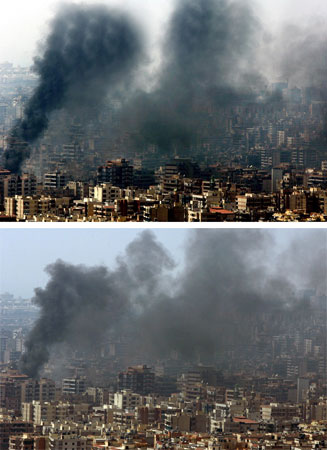
The altered photo (top) and the real one (below). A Lebanese freelancer named Adnan Hajj who was working in Beirut altered at least two photographs: In this one he cloned a plume of smoke rising from buildings that Israeli planes had bombed.
Read also this article from Jim Lewis. It was published in 2006, but provides lots of examples of upside-down journalism:
Thursday, Aug. 10, 2006 | By Jim Lewis
Don’t Believe What You See in the Papers
The untrustworthiness of news photography
There’s an old joke about a Southern preacher who’s asked by a skeptical congregant if he really believes in infant baptism. “Believe in it?” the preacher replies. “Why, I’ve seen it done!”
I thought of the preacher when I heard the latest in photojournalism’s long line of mini-scandals, this one involving a Lebanese freelancer named Adnan Hajj who was working in Beirut. Hajj altered at least two photographs: In one he cloned a plume of smoke rising from buildings that Israeli planes had bombed; in another he altered the image of an Israeli F-16 to make it look like it was dropping more ordnance than it was. Both pictures were bought by Reuters, which sent them out on its photo service. When the forgeries were pointed out, the agency pulled the pictures, dismissed the photographer, and issued a statement asserting that such fakery had no place in the news business.
It may not, but that doesn’t mean it doesn’t happen regularly. Two days ago, the AP got caught sending out a crudely—and nonsensically—altered photo of an Alaskan oil pipeline worker; last month, the Charlotte Observer fired a photographer for changing the color of the sky in a picture of a firefighters; the same week, the Spanish-language edition of the Miami Herald acknowledged that a picture of prostitutes in Havana had been cobbled together from two different shots; in 2003 the Los Angeles Times sacked a photographer for combining two pictures from Iraq, taken moments apart, into one. In fact, it’s beginning to look as if every major institution that prints photos has printed doctored or manipulated photos: Time and Newsweek, the New York Times and USA Today, Harvard University and Science magazine, and the 2004 Bush campaign. (There’s a good rogue’s gallery here.) Some of these were quite serious attempts to mislead the public, and some were relatively trivial, but all of them undermine the public’s trust in the reality of photographs. And so much the better, because that trust is badly misplaced.
What, after all, do we believe when we believe that a photograph is true? That it mimics what we would see with our own eyes, if we were standing where the camera was placed?
[…]
Perhaps, instead, we should judge a news photograph as a collection of purported facts about the world that is accurate if its claims are true and inaccurate if they’re not. But photographers make editorial decisions all the time: where to point the camera, of course, but also how to frame the shot, whether to crop and if so what, how long a shutter speed to use; and all of these can affect the facts a picture presents, without falsifying the image. And anyway, which facts are relevant? Last week the Times ran an impressive graphic showing before and after satellite photographs of a bombed Beirut neighborhood, but the “before” picture was in blooming color and the ‘after’ picture was in black and white. Many people would say that the black-and-white shot was more “realistic” because monochrome seems to offer a kind of sobriety. But of course color is closer to the facts, and even color is unreliable.
[…]
To make matters more complicated, news photographs are made by more hands than the photographer’s. Editors at home will sometimes crop a picture, or clean it up, and they’ll often flesh out captions, which can radically change what we think we’re looking at. Hajj’s photo of the Israeli F-16 bore a caption that said the jet was dropping missiles; in fact they were flares, but who could know that just by looking? What you see when you contemplate a news photo is what you’re told to see. And sometimes it’s what you’re allowed to see: When Ronald Reagan visited Bitburg cemetery in 1985, photographers were forced to shoot from vantage points that prevented them from getting both the president and the gravesites of the Nazi Waffen SS who were buried there in a single frame. Were the pictures that came out of that event “true”? They certainly weren’t fake, but if you were a photo editor, would you have run them? Inasmuch as photojournalism is meant to impart information, the Bitburg pictures were as misleading as Hajj’s clumsily darkened smoke plumes. Imposture can take many forms.
Read full article here.
You can find another example of anti-Israeli biased news coverage here: the cropped Reuters Photo’s about the Mavi Marmara incident.



 RSS
RSS

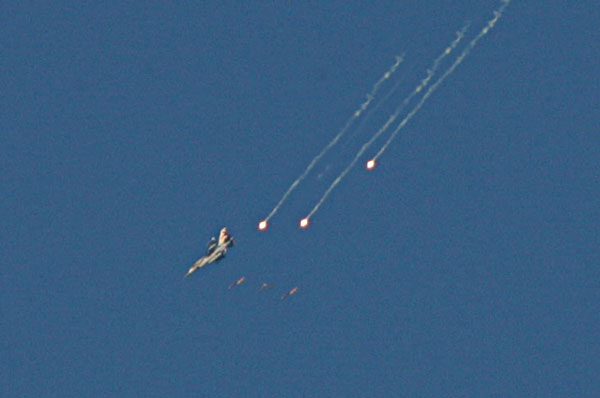
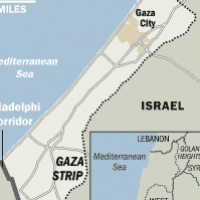
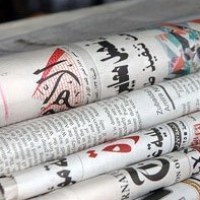
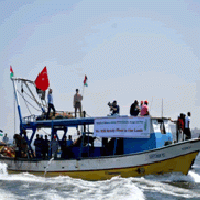






Upside-Down #Journalism: Don't Believe What You see in International News #Media | #Israel #MiddleEast http://j.mp/hfxwPK
RT @CrethiPlethi: Upside-Down #Journalism: Don't Believe What You see in International News #Media | #Israel #MiddleEast http://j.mp/hfxwPK
[…] photographs also arose during the 2006 Lebanon War, where a photographer called Adnan Hajj crudely photo-shopped images to worsen Israel’s portrayal. The manipulations were only discovered by internet bloggers due to […]